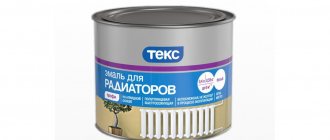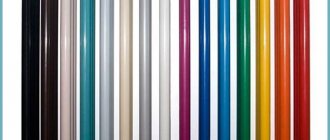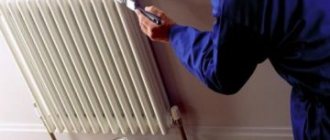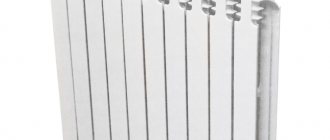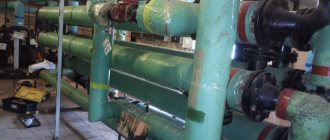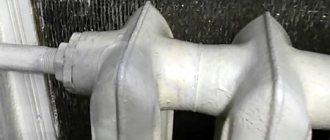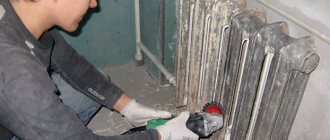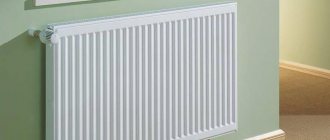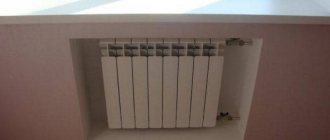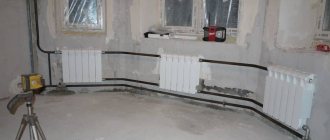When repairing there are no trifles, all details deserve attention, including heating radiators, which are an integral part of any home. Batteries must correspond to the overall interior, harmonize with it and support its mood. In order for them to serve for many years and at the same time look neat, it is necessary to provide them with regular and proper care.
Radiators should be coated only with high-quality paints and varnishes that are resistant to high temperatures. A well-chosen composition does not peel off or spread, and its reliability does not raise questions. Let's try to understand all the intricacies of choosing enamel for radiators, and whether they can be used to paint hot radiators.
How not to dilute enamel for heating radiators
The appearance of cast iron heating radiators requires periodic updating. This is necessary not only for aesthetics, but also to extend service life. Aluminum and steel radiators have a special powder coating and, as a rule, do not need to be repainted. Today there are many varieties of paints on sale designed specifically for radiators. Enamels are best suited for cast iron batteries. Which ones exactly, how to apply them correctly, what can and cannot be used to dilute enamel paints - we will talk about this below.
Types of enamels for cast iron batteries
Despite the modern abundance of heating radiators, cast iron batteries continue to be in demand. There are quite a lot of reasons for this, and it makes no sense to list them. Cast iron radiators require periodic surface painting. In this case, the paint must meet the following requirements:
- Maintain a temperature of about 80 C.
- Be environmentally friendly.
- It is good to protect the surface and give it an attractive appearance.
- Maintain the original appearance for a long time.
During the Soviet shortage, the choice was, to put it mildly, small: oil paint or silver paint. Today, several types of enamels are used to paint radiators:
Alkyd - creates a durable coating on the surface that can maintain the integrity of the structure for a long time. Among the shortcomings, one can note, first of all, a pungent odor that does not disappear for a long time. You can dilute alkyd enamel to the desired consistency:
- White spirit;
- Solvent;
- Xylene;
- Turpentine;
- 646 solvent.
It is highly not recommended to dilute paint with gasoline and diesel fuel.
Water-dispersed alkyd enamel
It dries very quickly, does not have a repulsive odor, and is strong and durable. It is diluted, as the name implies, with ordinary clean water. Other solvents are not recommended.
Acrylic enamel
Advantages - the surface does not need to be primed, the paint is very easy to apply, it dries quickly and does not smell. Acrylic paints are diluted with water, alcohol diluted with water, as well as special acrylic thinners. Universal solvents are not suitable for acrylic paints.
In order not to make a mistake when choosing a solvent for enamel, you need to clearly know its composition. The universal solvent is considered to be 646 nitro solvent. However, some enamels cannot be diluted with products that contain acetone, as they curl. Manufacturers always indicate recommended enamel thinners on the label, which cannot be replaced with analogues.
Painting technology
Before painting radiators during the heating season, you should familiarize yourself with the rules for performing the work and purchase the necessary materials and tools.
The quality of painting depends on compliance with the technology for preparing the surface for painting work and on the correct choice of paint. The process of painting a hot battery is accessible to any beginner, but some of the secrets of the skill given below will help you complete this job faster and with higher quality.
Materials and tools
Before painting hot radiators in an apartment, you need to purchase materials and tools.
Materials you will need:
- paint (alkyd or acrylic, a special water-based paint is also suitable, but it is better to avoid oil paint, as it takes a long time to dry);
- solvent for old paint;
- primer for metal;
- polyethylene film to protect floors and walls.
You need to prepare the following tools:
- scraper for removing old coating;
- medium-grit sandpaper;
- flute brush 50 and 20 mm wide;
- brush with a curved handle 20 mm wide.
Preparatory work
First of all, it depends on the correct preparation of the base whether it will be possible to paint the batteries in winter with high quality.
When preparing the radiator surface for painting, you must adhere to the following sequence of actions:
- The battery must be freed from dust and dirt.
- Next, the radiator is carefully inspected to identify pockets of corrosion on the surface.
- At the next stage of preparation, you need to remove the old paintwork, for which you use sandpaper and a scraper.
- The cleaned surface of the radiator is treated with a primer solution. Applying a primer to the surface to be painted allows you to level the base and remove small pores, which will ensure more reliable adhesion of paint and metal. The primer is selected taking into account the type of paint.
- The work area is covered with plastic film. You need to protect not only the floor, but also the walls around the radiator.
The main difficulty in preparation lies in removing the old coating. There are several ways to get rid of old paint, but the most accessible method is the chemical method. To prepare the cleaning composition you will need to purchase: soda ash - 1 kg and slaked lime - 1 kg, you will also need 5 liters of water.
The process of preparing the washing solution:
- pour hot water into a large container (at least 10 liters) and dissolve soda ash in it;
- then add slaked lime in small portions;
- The mixture is thoroughly mixed, after which it should be allowed to stand for 10-15 minutes.
Apply the finished mixture to the surface of the radiator, leave for 5-10 minutes and begin scraping off the paint with a scraper.
After completing all the steps to prepare the surface for painting, you can begin the main work.
Painting instructions
When painting a battery, it is recommended to adhere to the following rules:
- Check whether the walls and floor are reliably protected from paint. If necessary, add additional sheets of film;
- Before starting work, you should read the instructions for the paint composition and, if necessary, mix the contents of the jar to obtain a homogeneous mass;
- They start painting the radiator from the most inconvenient and hard-to-reach places. For these works, narrow flute brushes and brushes with curved handles are used;
- The outer parts of the radiator are painted with wider brushes or a small roller;
- It is recommended to paint from top to bottom. This makes it easier to avoid leaks;
- To obtain a reliable coating, two layers of paint must be applied. The second layer is applied after the first layer has completely dried.
If a can of aerosol paint was selected for work, spraying is carried out from a distance of at least 300 mm.
Upon completion of work, it is recommended to ventilate the room.
The recommendations listed above make it possible to remove the question of whether it is possible to paint radiators while the heating is on - if all requirements are met, heating radiators can be painted even at high temperatures in the heating network.
How to dilute acrylic paint?
Acrylic paint is a safe, non-toxic paint and varnish material made on the basis of pigment, a binding component, and water. After evaporation and complete drying of the water base, a frost-resistant, elastic, cracking and delamination-resistant protective coating is created. This type of paint is used for painting wooden, metal, and plastered surfaces.
It has special advantages compared to other paints and varnishes:
– environmental friendliness – complete safety for health and the environment due to the absence of toxic substances;
– the widest color palette;
– comfort of use, achieved by quick drying of the painted surface, ease of use, including washing;
– absence of unpleasant odor, which allows you to dispense with a respirator mask when working;
– long service life – at least ten years;
– the acrylic layer does not allow water to pass through.
There are several types of acrylic paint depending on the following indicators:
– application option (external and internal work);
– resistance to environmental factors (moisture resistance, light resistance, resistance to mechanical factors);
– gloss and degree of whiteness;
According to its structure, acrylic paint is a thick material that requires dilution before work to ensure convenient application and uniform distribution. The need for dilution arises after the material has been open for a long time.
There are several options for thinners.
Additional recommendations
Working with acrylic paints has nuances and secrets. Here are some of them:
The water must stand for 2-3 hours so that the impurities settle to the bottom. Only after this can it be used to dilute acrylic paints.
When applying the composition using a spray gun, work with branded solvents, adhering to the proportions recommended by the manufacturer. This way you will get a liquid of uniform consistency and achieve uniform coloring of the surface.
Rinse brushes and rollers thoroughly, especially if the work was performed with a highly diluted liquid. This composition is difficult to notice, so the particles remain between the villi. If you subsequently use paint of a lighter shade, the color will be spoiled.
Add the diluent to the composition in portions, thoroughly mixing the composition after each dose. To do this, use a special mixer.
It is not recommended to purchase the material “back to back” - it is advisable to leave a small amount of paint unused. This is necessary for spot restoration of the surface in case of accidental damage.
Regardless of what you choose to thin your acrylic paint with, test the product with a small amount of colorant. If you notice the formation of lumps, you will have to choose another option.
When renovating residential or industrial premises, almost every person wants to choose high-quality consumables that are safe for health and have good performance. A particularly important issue in this matter is the choice of paint for radiators. The difficulty is that if it is chosen incorrectly, it will take quite a long time for the treated surfaces to dry completely. Then, when the radiators are heated, the room will constantly be filled with a pungent and unpleasant odor, and the layer will easily peel off.
Diluting acrylic paints with water
The basis of acrylic paints and varnishes is water, so it is advisable to use it to achieve the required consistency. An important point: you need to use only clean and cold water, standing for several hours or distilled, to prevent interaction between the components of the paint and varnish material and the thinner.
– dilution with water 1:1 – the material can be used to create a base layer, the paintwork lays down evenly, without smudges or sagging, forming a uniform coating that effectively protects the surface from corrosion and aggressive environmental influences;
– 1:2 – the consistency is more liquid, allowing you to create a thin and even layer, the paintwork material saturates the brush or roller well;
– 1:5 – creates “colored water”, which is used to color textured details; the composition is well absorbed and fills depressions and other depressions on the surface;
– 1:15 – the proportion is not used often, it is intended to create a transition between tones (gradient); in fact, it is no longer paint, but colored water.
After applying acrylic water-based paint and varnish material, you must immediately thoroughly clean the tool used. This is explained by the fact that after drying, water-based acrylic paintwork becomes water-resistant. And, accordingly, rollers, brushes and other painting tools, once dry, cannot be cleaned.
Causes of drying out
The main reasons for acrylic paint drying out are:
- loose closure of the lid of a container with acrylic, violation of the integrity of the jar or tube;
- storage at high temperatures, under direct sunlight, etc.;
- using paint after the expiration date specified by the manufacturer;
- long-term painting, frequent opening of containers when working with the surface to be painted;
- evaporation of the solvent that was introduced to restore the paint under the influence of elevated temperatures.
The optimal consistency of the prepared paint is maintained only at a temperature of +15…+25°C. In cold weather, acrylic can become thicker, causing it to be applied in thick layers.
Dilution with special acrylic thinners
Dilution with water or water with alcohol is only permissible when using a roller or brush. Paint sprayers and spray guns (painting equipment) require the use of acrylic thinners, the brand of which must be indicated by the manufacturer on the packaging. They have a specific smell and transparent appearance. The required amount of addition of such liquid depends on the scope of application, temperature and humidity of the external environment. Depending on the composition, acrylic solvents create a matte or glossy layer on the surface. Different coloring effects are achieved using a certain proportion, which is usually indicated on the thinner packaging.
Advantages of using acrylic solvent:
– accelerated drying time;
– the ability to create a matte or glossy surface;
– formation of an even layer without streaks and white deposits;
– chemical purity, compared to water;
– increased stability of paint characteristics.
Features of working with acrylic
Acrylic paints can be diluted with water or other thinners that will change their properties when drying. For example, you can add gloss by mixing with varnish or, conversely, matte with oil. You can also add shine using hairspray by sprinkling it after the paint has dried. Thanks to the solvent, it is possible to improve the fluidity of acrylic so that it is convenient to paint large surfaces or work with a paint roller.
They can be used for priming canvases and other surfaces. Using acrylic, you can get both a smooth base and a textured one.
Other interesting questions and answers
Why does sulfuric acid dissolve everything except the jar it is in?
Sulfuric acid does not dissolve everything. In particular, it does not dissolve glass, quartz, many types of plastic, many ceramic materials (for example, porcelain), gold-platinum, etc. and so on. Chemical glassware is usually made of glass or resistant plastic, so sulfuric acid does not dissolve most chemical glassware.
Sulfuric acid dissolves, either, in fact, as an acid (i.e. metals, their oxides/hydroxides, salts of weak acids, etc.), or as an oxidizing agent (organic substances, some non-metal compounds, and in general most of what that at least somehow oxidizes). However, many substances are not compounds of active metals and do not exhibit noticeable reducing properties. Sulfuric acid does not dissolve them or dissolves very slowly - for example, aluminum oxide is theoretically soluble in sulfuric acid, since it is still a metal oxide, albeit with amphoteric properties, but practically for ceramics or a single crystal the dissolution rate is so low that it is negligible and, in principle, possible say that they are resistant to sulfuric acid (although, say, I would not bathe an optical single crystal in sulfuric acid, it may become cloudy, etc.).
There are also some passivation mechanisms when dissolving something theoretically soluble in sulfuric acid (mainly concentrated), but these are details.
Alexander Vanetsev 5
Hello. How to wash microfiber half shoes?
Is it possible to dilute battery paint with color and paint it?
I have two rooms in which I want to paint the batteries beige, I have the brown Dufa color that is used to decorate the walls, and I want to add this color to a can of paint for the batteries, is it worth it?
Why not! Now the white color of heating radiators has long been no longer a constant or mandatory, as in Soviet times in all institutions and organizations. Which, in turn, entailed painting in residential buildings - after all, housing offices were also subject to various decrees, regulations and orders. For example, I have the walls in one room painted golden and I painted the radiators to match the walls, adding ocher pigment to the white paint. The combination is just super, in the other room the walls are slightly with lapis lazuli and the radiators are light blue, rather even light turquoise - it also looks good. So, it all depends on taste and desire! You can immediately buy the paint of the desired color, or you can buy the required pigment separately and mix it with the paint. Pigments are now sold in any hardware store or on the market, the main thing is that the paint holds well the temperature that the radiators will have in winter. Therefore, under no circumstances should it be water-based or nitro paint. The best thing is either oil or enamel, but it is enamel that applies better, holds the temperature, and looks great!
